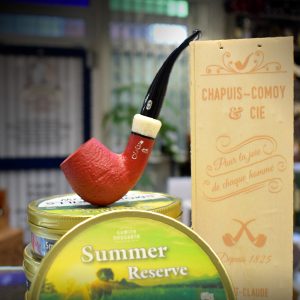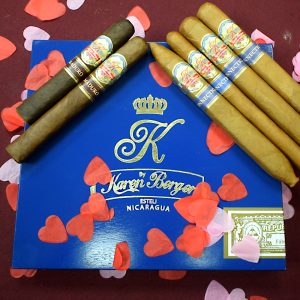 Hi all, been a bit of a funny couple of weeks as both me and Sharon have been struggling with illness but we battle on through ensuring you get the top service you deserve and keeping our beautiful store exquisite!
Hi all, been a bit of a funny couple of weeks as both me and Sharon have been struggling with illness but we battle on through ensuring you get the top service you deserve and keeping our beautiful store exquisite!
We have been very busy with pickings and it seems to be that people have been taking advantage of our January sales, with many people taking advantage of our great deals! Afterwards, I finished writing my latest article on Chacom pipes and took all the pictures for it. My pictures were so good it actually featured in one of our newsletters for last week! I’m not a photographer by any means I just give it a go and thankfully the marketing team have helped me improve and even like my work.
On Tuesday I had two marketing meetings! So once I finished picking orders I had my first one. It was all about us using Linkedin more and using it to communicate to our customers (like yourself) and a wider audience. Feel free to add me on there and you can enjoy things that I post and I’m sure we will get chatting soon. The second meeting (which happened to be in the local wetherspoons) was about our marketing plans for the future so watch this space! Once I got back I had noticed Sharon had moved around the alcohol shelves into a better order putting some gift packs out too as we have many customers buying gifts so it only made sense. Later in the afternoon I finished planning Marchs cigar subscription and I can tell you that it is a really good one! If you’re interested click here, you pay £74.99 but Marchs subscription is actually worth almost £100! You’d be silly not to get one!
 Thursday I had a lovely customer with his wife and son come in who i believe are starting to become regulars, they like looking at the pipes together and the gentleman always asks his wife if she likes it which I think is sweet as i’m sure she looks at it while he smokes it and his little one was cute and couldn’t stop staring at me – not sure if that’s a good thing or not…
Thursday I had a lovely customer with his wife and son come in who i believe are starting to become regulars, they like looking at the pipes together and the gentleman always asks his wife if she likes it which I think is sweet as i’m sure she looks at it while he smokes it and his little one was cute and couldn’t stop staring at me – not sure if that’s a good thing or not…
We are also starting a new cigar promotion in store! We have some disbanded cigars and all you have to do is purchase one for £12.99 and then guess what the cigar is once you’ve smoked it. If you are correct we will add 500 loyalty points to your account, its that simple so good luck! Sharon has decorated our shop ready for Valentines day, adding new displays to our existing ones and theming the centre display for his and hers.
On Friday I finished my article about K by Karen Berger cigars which you can read here. All pictures were taken by me too as I am enjoying photography more these days. Lewis, our content creator also wanted me to take a picture of our shop display for our shop newsletter with the lovely Sharon in ofcourse. She takes a lot of pride in her displays to the point that other members of staff are scared to touch them 😉 She is holding a bottle of Foragers Winberry Gin which she thinks is the best gin out of the range.
 On Saturday I was determined to re-organise the pipe room, it always looks nice but I felt like it could have been better and it was a bit rough around the edges. So I moved pipes around the room, stocked and even explored corners I’ve never looked at before and found so many old displays that I have never seen before! I have worked here for three years and found so many things that I didn’t know we even had! After tidying up I carried on the non-stop task of stocking the humidor as by the time I have stocked it up we sell almost everything and I have to start all over.
On Saturday I was determined to re-organise the pipe room, it always looks nice but I felt like it could have been better and it was a bit rough around the edges. So I moved pipes around the room, stocked and even explored corners I’ve never looked at before and found so many old displays that I have never seen before! I have worked here for three years and found so many things that I didn’t know we even had! After tidying up I carried on the non-stop task of stocking the humidor as by the time I have stocked it up we sell almost everything and I have to start all over.
I hope you are enjoying my blogs so far and if you want to know anymore feel free to email me at [email protected]
So long for now
Oliver






 RC
RC





 In the last entry, I mentioned the ratio of tobacco formats across with range. But what about the other distinction between pipe tobacco blends: Trad/English blends (/aromatics) Vs Cased Aromatics? So far it stands at three English (No. 1, 4 and 5) and two cased aromatics. So it’s nice to see that Chacom No.6 rounds this out to 3:3. In my original blog on this range I commented on how much I appreciated them going a bit off-piste with their casing choices, shunning the more tried and true flavours such as cherry, in favour of things like Yellow Plum and Vanilla Bourbon. I’m ecstatic to see they’ve carried this ethos forward by using a combination of Rum, Espresso and Caramel, topping a classic aromatic base of Black Cavendish, Virginia and Burley.
In the last entry, I mentioned the ratio of tobacco formats across with range. But what about the other distinction between pipe tobacco blends: Trad/English blends (/aromatics) Vs Cased Aromatics? So far it stands at three English (No. 1, 4 and 5) and two cased aromatics. So it’s nice to see that Chacom No.6 rounds this out to 3:3. In my original blog on this range I commented on how much I appreciated them going a bit off-piste with their casing choices, shunning the more tried and true flavours such as cherry, in favour of things like Yellow Plum and Vanilla Bourbon. I’m ecstatic to see they’ve carried this ethos forward by using a combination of Rum, Espresso and Caramel, topping a classic aromatic base of Black Cavendish, Virginia and Burley.

 Consummate Gentleman
Consummate Gentleman burning. This is built upon with a stunning combination of Latakia, Turkish and Oriental tobaccos and a hint of Perique, creating a perfectly harmonised blend that is subtly sweet, while also showing off all the flavours that can be naturally coaxed from fine tobacco, without the need for casing or flavouring. There are hints of perfumed smoke, cracked black pepper, smoked wood, sweet smoked-cured meats, to name just a few. I compared Consummate Gentleman to the lighter, “introductory” English blends, such as Early morning and First Bowl. Artisan’s Blend is right on the other end of the spectrum, far more akin to the heady, full bodied likes of
burning. This is built upon with a stunning combination of Latakia, Turkish and Oriental tobaccos and a hint of Perique, creating a perfectly harmonised blend that is subtly sweet, while also showing off all the flavours that can be naturally coaxed from fine tobacco, without the need for casing or flavouring. There are hints of perfumed smoke, cracked black pepper, smoked wood, sweet smoked-cured meats, to name just a few. I compared Consummate Gentleman to the lighter, “introductory” English blends, such as Early morning and First Bowl. Artisan’s Blend is right on the other end of the spectrum, far more akin to the heady, full bodied likes of 
 After starting with an ever so slightly aromatic blend, I’m staying in the same area but turning the dial up significantly with Smooth Sailing. It is a Virginia, Burley and Cavendish blend, topped with a flavour of nuts, cocoa and maple. This is the blend I referred to in the intro as one of my favourite aromatics ever. The reason I like it so much is that it’s a really nice change from the more common fruity aromatics on the market. It has much more of a pudding-y or cakelike taste. The fact I use the word “Taste” there is relevant too; many blends sneakily call themselves “Aromatic” rather than “Flavoured” to protect themselves in the event of people saying they don’t think the taste is as good as the aroma. Well, Smooth Sailing can confidently call itself a Flavoured tobacco, as it tastes just as good as it smells… and that taste is divine.
After starting with an ever so slightly aromatic blend, I’m staying in the same area but turning the dial up significantly with Smooth Sailing. It is a Virginia, Burley and Cavendish blend, topped with a flavour of nuts, cocoa and maple. This is the blend I referred to in the intro as one of my favourite aromatics ever. The reason I like it so much is that it’s a really nice change from the more common fruity aromatics on the market. It has much more of a pudding-y or cakelike taste. The fact I use the word “Taste” there is relevant too; many blends sneakily call themselves “Aromatic” rather than “Flavoured” to protect themselves in the event of people saying they don’t think the taste is as good as the aroma. Well, Smooth Sailing can confidently call itself a Flavoured tobacco, as it tastes just as good as it smells… and that taste is divine.


 Next up we have Sea Weed. This takes us in a different direction as it is a traditional yet striking Scandinavian style aromatic tobacco. The tobacco blend is a mix of Virginia, Burley and Black Cavendish, with a “Caramel and Cream” casing. One thing that immediately struck me on opening the tin was just how pronounced the “Cream” element of the casing is. All too often, when tobaccos promise a cream flavour, it turns out to be a bit nothing-y; just a vague hint or a light tobacco that gives the impression of creaminess. However, I’ll be damned if this blend doesn’t actually smell and taste of cream. The caramel side of the casing pulls its weight equally well too, which when combined with the cream taste, gives a flavour similar to crème brulee. As far as the casing: tobacco taste ratio goes, I’d call this a textbook Scandinavian aromatic, as the casing is strong enough to be noticed, but not so strong that you can’t taste the tobacco. Perfect balance.
Next up we have Sea Weed. This takes us in a different direction as it is a traditional yet striking Scandinavian style aromatic tobacco. The tobacco blend is a mix of Virginia, Burley and Black Cavendish, with a “Caramel and Cream” casing. One thing that immediately struck me on opening the tin was just how pronounced the “Cream” element of the casing is. All too often, when tobaccos promise a cream flavour, it turns out to be a bit nothing-y; just a vague hint or a light tobacco that gives the impression of creaminess. However, I’ll be damned if this blend doesn’t actually smell and taste of cream. The caramel side of the casing pulls its weight equally well too, which when combined with the cream taste, gives a flavour similar to crème brulee. As far as the casing: tobacco taste ratio goes, I’d call this a textbook Scandinavian aromatic, as the casing is strong enough to be noticed, but not so strong that you can’t taste the tobacco. Perfect balance. Vanilla casing. Classic, right? The reason I call this blend “arresting” is that the aromatic casing is surprisingly pronounced for a Scandinavian Style Aromatic. The blenders also describe a more floral element, along with the vanilla, but to me it all comes together to make something a bit different. This is especially noticeable in the cold aroma. In fact, from the second you unseal and unscrew the lid, the aroma immediately seeps out to entice anyone in the vicinity. This aroma lead to a debate between me and my colleague, Karen. My immediate thought on the aroma was chocolate sponge cake, while she thought it was more of a fruit cake. Either way, we could agree it was definitely very “Cakey.” Once lit, I found the taste to be a combination of chocolate and a gentle vanilla undertone. Once again, I found the casing to be surprisingly strong for a Scandi Aro – almost bordering on American Style – but I could just about taste the tobacco underneath.
Vanilla casing. Classic, right? The reason I call this blend “arresting” is that the aromatic casing is surprisingly pronounced for a Scandinavian Style Aromatic. The blenders also describe a more floral element, along with the vanilla, but to me it all comes together to make something a bit different. This is especially noticeable in the cold aroma. In fact, from the second you unseal and unscrew the lid, the aroma immediately seeps out to entice anyone in the vicinity. This aroma lead to a debate between me and my colleague, Karen. My immediate thought on the aroma was chocolate sponge cake, while she thought it was more of a fruit cake. Either way, we could agree it was definitely very “Cakey.” Once lit, I found the taste to be a combination of chocolate and a gentle vanilla undertone. Once again, I found the casing to be surprisingly strong for a Scandi Aro – almost bordering on American Style – but I could just about taste the tobacco underneath.







